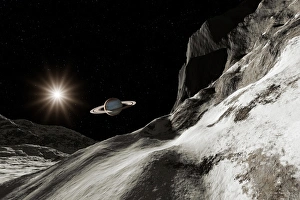Iapetus Collection
Iapetus, Saturn's enigmatic moon, has captivated astronomers and space enthusiasts alike with its mysterious features
All Professionally Made to Order for Quick Shipping
Iapetus, Saturn's enigmatic moon, has captivated astronomers and space enthusiasts alike with its mysterious features. Discovered by Giovanni Domenico Cassini in the 17th century, it has remained a celestial puzzle waiting to be unraveled. Through stunning illustrations like "Saturn like a setting sun, " we catch a glimpse of the awe-inspiring beauty that this moon possesses. The litho artwork showcases the ethereal nature as it orbits around its colossal parent planet. NASA's images provide us with an unprecedented view of Iapetus' speckled surface, resembling an otherworldly canvas painted by cosmic forces. A scene of craters tells tales of ancient impacts that have shaped this celestial body over billions of years. Intriguingly, anaglyph imagery reveals massive mountains adorning Iapetus' landscape – a sight that leaves us in awe at nature's grandeur on distant moons. These breathtaking pictures were captured thanks to NASA's relentless pursuit of knowledge about our solar system. As we delve deeper into understanding Iapetus, maps created in 2008 offer valuable insights into its topography and composition. They guide us through its complex terrain and help unravel the secrets hidden within this enigmatic world. But what lies beyond? The other side beckons exploration, inviting us to uncover more mysteries lurking beneath its surface. With each passing discovery comes a complex transition from ignorance to enlightenment – reminding us how little we truly know about our vast universe. From Giovanni Domenico Cassini's initial sighting to modern-day satellite imagery, our closest views yet have only scratched the surface when it comes to comprehending the wonders held within Iapetus' domain. As humanity continues venturing further into space exploration, one thing remains certain: there is still so much left for us to discover about this captivating moon orbiting Saturn.










